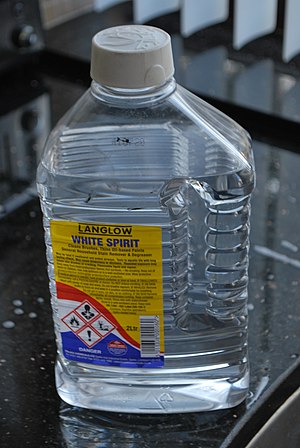White spirit
(Redirected from Mineral spirits)
White spirit, also known as mineral spirits, is a clear, colorless solvent used in many industries and applications primarily for cleaning, degreasing, and thinning purposes. It is a petroleum-derived solvent that consists of aliphatic, alicyclic, and a small proportion of aromatic hydrocarbons. Due to its low odor and less toxic nature compared to other solvents, white spirit is widely utilized in painting, decorating, and cleaning.
Composition[edit | edit source]
White spirit is composed of a mixture of hydrocarbons, primarily in the C7 to C12 range, which includes aliphatics, alicyclics, and a minor fraction of aromatics. The exact composition of white spirit can vary based on its type and the refining process used to produce it. There are different types of white spirit, categorized based on their aromatic content and boiling point range, which affects their evaporation rate and solvency power.
Types[edit | edit source]
There are generally three types of white spirit:
- Type 1: Low aromatic content (typically less than 15%)
- Type 2: Contains a higher proportion of aromatic hydrocarbons
- Type 3: Odorless type, further refined to remove most of the aromatic content
These types are designed to meet various requirements for solvency, odor, and drying time for different applications.
Uses[edit | edit source]
White spirit is extensively used in the following applications:
- Paint Thinner: It is commonly used to thin oil-based paints, varnishes, and enamels, improving their application and drying properties.
- Cleaning Agent: White spirit is effective in cleaning painting tools, such as brushes and rollers, and removing oil, grease, and grime from surfaces.
- Degreasing: In automotive and machinery maintenance, it is used to degrease engine parts and tools.
- Dry Cleaning: It serves as a solvent in some dry cleaning formulations.
Health and Safety[edit | edit source]
Exposure to white spirit can pose health risks, including respiratory irritation, dermatitis, and central nervous system effects such as dizziness and headache with prolonged inhalation of high concentrations. It is less toxic than many other solvents, but adequate ventilation and protective equipment are recommended during use. White spirit is also flammable, requiring proper storage and handling to prevent fire hazards.
Environmental Impact[edit | edit source]
The environmental impact of white spirit is a concern, particularly when it enters waterways or soil, where it can harm aquatic life and disrupt ecosystems. Proper disposal and recycling of white spirit are essential to minimize its environmental footprint.
Regulation[edit | edit source]
The production, labeling, and use of white spirit are regulated in many countries to ensure safety and environmental protection. Regulations may specify permissible exposure limits, labeling requirements, and disposal guidelines.
| White spirit Resources | |
|---|---|
|
|
Search WikiMD
Ad.Tired of being Overweight? Try W8MD's physician weight loss program.
Semaglutide (Ozempic / Wegovy and Tirzepatide (Mounjaro / Zepbound) available.
Advertise on WikiMD
|
WikiMD's Wellness Encyclopedia |
| Let Food Be Thy Medicine Medicine Thy Food - Hippocrates |
Translate this page: - East Asian
中文,
日本,
한국어,
South Asian
हिन्दी,
தமிழ்,
తెలుగు,
Urdu,
ಕನ್ನಡ,
Southeast Asian
Indonesian,
Vietnamese,
Thai,
မြန်မာဘာသာ,
বাংলা
European
español,
Deutsch,
français,
Greek,
português do Brasil,
polski,
română,
русский,
Nederlands,
norsk,
svenska,
suomi,
Italian
Middle Eastern & African
عربى,
Turkish,
Persian,
Hebrew,
Afrikaans,
isiZulu,
Kiswahili,
Other
Bulgarian,
Hungarian,
Czech,
Swedish,
മലയാളം,
मराठी,
ਪੰਜਾਬੀ,
ગુજરાતી,
Portuguese,
Ukrainian
Medical Disclaimer: WikiMD is not a substitute for professional medical advice. The information on WikiMD is provided as an information resource only, may be incorrect, outdated or misleading, and is not to be used or relied on for any diagnostic or treatment purposes. Please consult your health care provider before making any healthcare decisions or for guidance about a specific medical condition. WikiMD expressly disclaims responsibility, and shall have no liability, for any damages, loss, injury, or liability whatsoever suffered as a result of your reliance on the information contained in this site. By visiting this site you agree to the foregoing terms and conditions, which may from time to time be changed or supplemented by WikiMD. If you do not agree to the foregoing terms and conditions, you should not enter or use this site. See full disclaimer.
Credits:Most images are courtesy of Wikimedia commons, and templates Wikipedia, licensed under CC BY SA or similar.
Contributors: Prab R. Tumpati, MD

